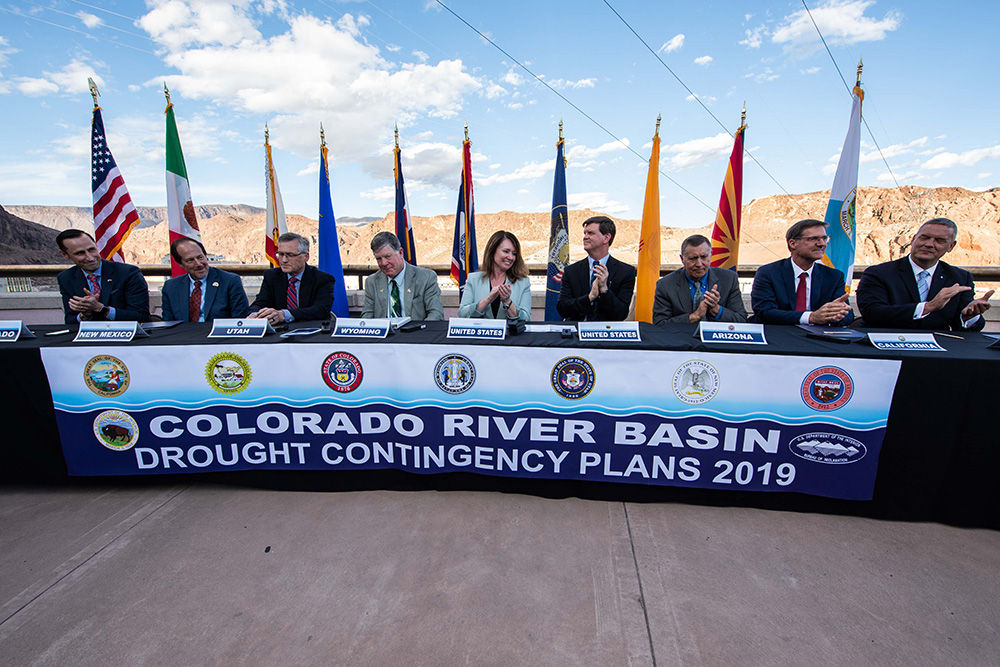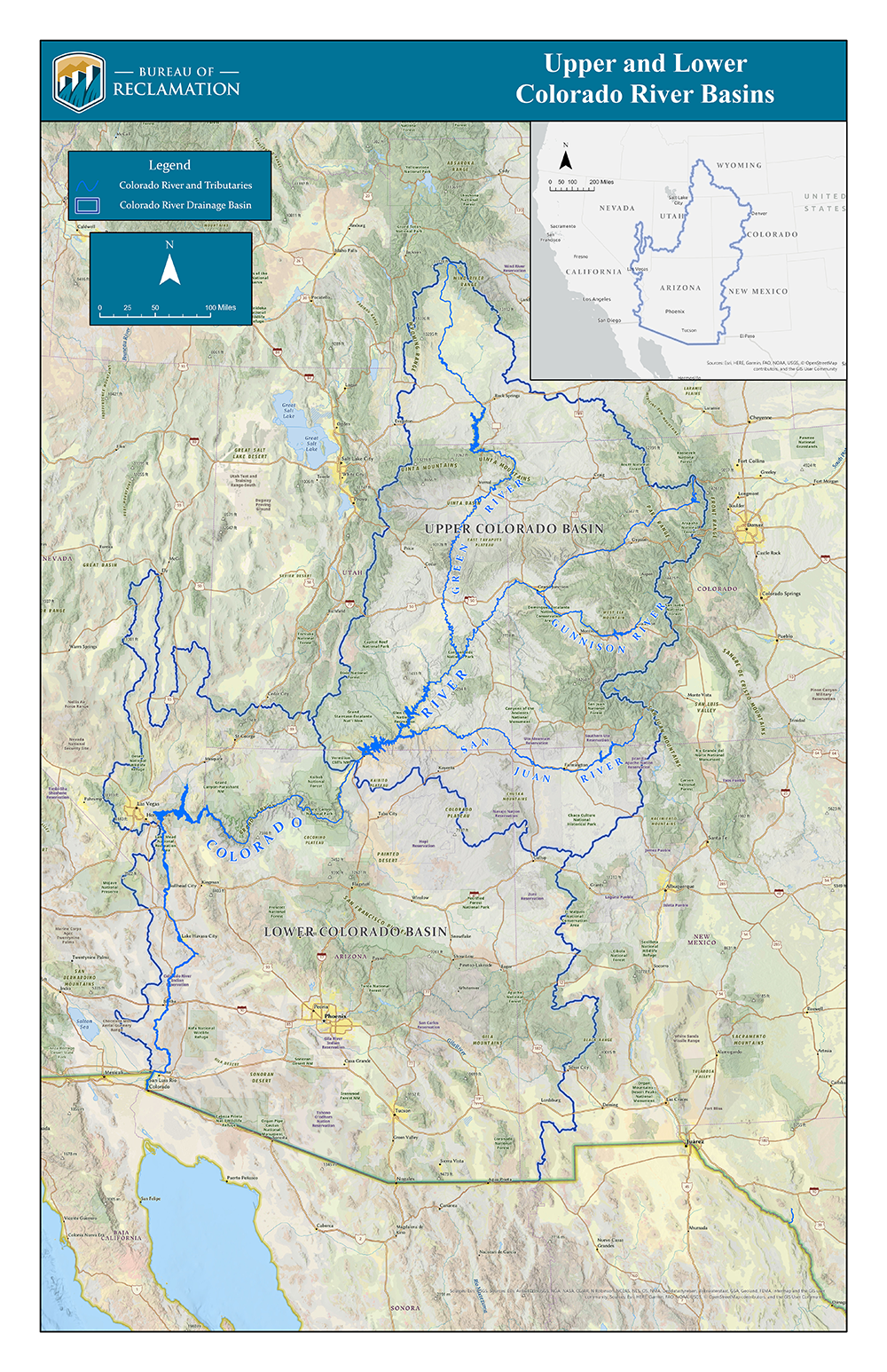- Reclamation
- Colorado River Basin
- Drought Contingency Plans
Drought Contingency Plans
In 2019, the Upper Basin and Lower Basin Drought Contingency Plans were signed. The DCPs outline strategies to address the ongoing historic drought in the Colorado River Basin.
The Upper Colorado Basin DCP is designed to reduce the risk of reaching critical elevations at Lake Powell and to help assure continued compliance with the 1922 Colorado River Compact.
The Drought Response Operations Agreement is one element of the Upper Colorado Basin DCP. The DROA identifies a process to temporarily move water stored in the Colorado River Storage Project Initial Units above Lake Powell — Aspinall, Flaming Gorge, and Navajo — to Lake Powell when it is projected to approach elevation 3,525 feet, which was identified in the DROA as the target elevation. This elevation provides a 35-foot buffer above the minimum power pool of 3,490 feet. Maintaining an elevation above 3,525 feet will help ensure compliance with interstate water compact obligations, maintain the ability to generate hydropower at Glen Canyon Dam, and minimize adverse effects to resources and infrastructure in the Upper Basin.
Pursuant to the DROA, Reclamation worked with the Upper Division States on a Drought Response Operations Plan (Plan) with the goal of implementing operational measures to augment water deliveries from the three upstream CRSP Initial Units to prop up Lake Powell. Reclamation continues to closely monitor hydrologic conditions and projections to identify appropriate upstream release volumes to maintain Lake Powell water level above the target elevation.
Drought Contingency timeline
-
May 2022: DROA releases begin to move an additional 500,000 acre-feet of water from Flaming Gorge Reservoir to Lake Powell (from May 2022 – April 2023).
Combined, the 2022 DROA release and the reduced annual release from Glen Canyon Dam will add approximately 1 maf of storage to Lake Powell, which is equivalent to approximately 16 feet in elevation.
-
January 2022: the Lower Colorado Basin declared the first shortage for calendar year 2022, resulting in water delivery reductions to Arizona, Nevada, and Mexico in the amounts of 320 kaf, 13 kaf, and 50 kaf, respectively.
For the first time in history, the annual release from Glen Canyon Dam was reduced from 7.48 million acre-feet to 7.0 maf.
-
Starting in July 2021: Drought response operations were implemented under the Upper Basin Drought Response Operations Agreement, which is part of the Upper Basin Drought Contingency Plans.
161,000 acre-feet of supplemental water was released from the upstream initial units of the Colorado River Storage Project Flaming Gorge Reservoir 125 kaf and Blue Mesa Reservoir 36 kaf.
-
Beginning in 2020: Conditions prompted the implementation of the Lower Basin Drought Contingency Plan and the Binational Water Scarcity Contingency Plan still in place currently.
o Arizona, Nevada, and Mexico contributed water savings to Lake Mead in the amounts of 192 thousand acre-feet in 2020, 8 kaf in 2021, and 41 kaf in 2022.
-
May 20, 2019: Interior and states sign historic drought agreements to protect Colorado River
 The Department of the Interior, Bureau of Reclamation and representatives from all seven Colorado River Basin states gathered today and signed completed drought contingency plans for the Upper and Lower Colorado River basins. These completed plans are designed to reduce risks from ongoing drought and protect the single most important water resource in the western United States. Read More...
The Department of the Interior, Bureau of Reclamation and representatives from all seven Colorado River Basin states gathered today and signed completed drought contingency plans for the Upper and Lower Colorado River basins. These completed plans are designed to reduce risks from ongoing drought and protect the single most important water resource in the western United States. Read More... -
April 9, 2019: Statement by Reclamation Commissioner Brenda Burman on historic legislation to implement Drought Contingency Plans
I’m pleased that collaborative efforts among the seven Colorado River Basin states, local water agencies, Tribes, non-governmental organizations, Mexico and the Department of the Interior to reduce risk on the Colorado River are succeeding. I applaud Congress for taking prompt action on implementing legislation for the Drought Contingency Plans. This brings us one step closer to supporting agriculture and protecting the water supplies for 40 million people in the United States and Mexico. Working together remains the best approach for all those who rely on the Colorado River. Read More...
-
March 19, 2019: Department of the Interior Statement on Transmittal of Drought Contingency Plans by the Seven Colorado River Basin States and Key Water Districts to Congress for Implementation
Since 2000, the Colorado River Basin has experienced historic drought and dry conditions. Currently, the combined storage in Lakes Powell and Mead are at their lowest levels since Lake Powell initially began filling in the 1960s.
On February 6, 2019, the Department of the Interior published a notice in the Federal Register, 84 Fed. Reg. 2244, requesting input from the Governors, or designated Governors representatives, of the Colorado River Basin States regarding recommendations for potential actions by the Department of the Interior that: (a) would be appropriate to take to reduce the risks the Colorado River Basin is facing, and (b) could be adopted prior to the August 2019 determinations of operations for Lake Powell and Lake Mead in 2020, in the event that the Drought Contingency Plans (DCPs) could not be completed and promptly adopted.
On March 19, 2019, the Governor’s representatives of the seven Colorado River Basin States and key water districts formally submitted Drought Contingency Plans to Congress for immediate implementation. The Department of the Interior commends the Basin States and key water contractors on this important milestone. Given their successful efforts to reach consensus on the DCPs, the Department, by this statement, terminates its request for input from the Colorado River Basin States, as the immediate completion and implementation of the DCPs demonstrates the best path forward to: a) reduce the risks the Colorado River Basin is facing, and that b) can be adopted prior to the August 2019 determinations of operations for Lake Powell and Lake Mead in 2020.
-
Feb. 1, 2019: Interior and Reclamation seek formal input from Colorado River Basin states’ governors to protect Colorado River Basin
The Colorado River Basin is experiencing its worst drought in recorded history and water stored in Colorado River reservoirs is the lowest volume in over a half-century. Reclamation is currently working with each of the seven Colorado River Basin states to develop drought contingency plans (DCPs) which, if implemented, would reduce the risk of Colorado River reservoirs declining to critically low levels. After years of work, and delays, in December 2018, Reclamation’s Commissioner indicated that if the DCPs were not completed by January 31, 2019, Reclamation would issue a solicitation for input from the seven basin states’ governors regarding recommendations for potential actions by the Department of the Interior to reduce the risks of lakes Powell and Mead declining to critically low levels.
The basin states have not completed the DCPs. While unfinished, the Department takes particular cognizance of the fact that on January 31, 2019, the Arizona legislature passed – and Governor Ducey signed - legislation authorizing the director of the Arizona Department of Water Resources to execute the relevant interstate DCP agreements. Arizona is unique in the need for state legislative action to approve the DCPs and this important step may indicate that finalization of the DCPs is imminent.
A Federal Register notice indicates that the Department will accept input from the basin states’ governors beginning on March 4, 2019, for a 15-day period. As stated in the notice, the Department will ensure that information received from the governors will be promptly shared with Tribes, interested parties and the general public at the end of the comment period. This Departmental action was not our preferred approach. However, any further delay elevates existing risks in the basin to unacceptable levels. It is our hope that the basin states will promptly complete the DCPs, and if they are successful, we anticipate terminating our request for input and rescinding the request contained in the Federal Register notice.
-
Oct. 10, 2018: Colorado River Basin States make important progress towards adopting effective Drought Contingency Plans in 2018
In December 2017, Reclamation Commissioner Brenda Burman called on the seven Colorado River Basin states and water entitlement holders in the Lower Colorado Basin to continue developing Drought Contingency Plans (DCPs) in response to ongoing historic drought conditions in the basin and reduce the likelihood of Colorado River reservoirs – particularly Lake Powell and Lake Mead – further declining to critical elevations. All seven Colorado River Basin states have been working diligently throughout 2018 on a set of draft DCP agreements that would implement Drought Contingency Plans in the Upper and Lower Basins. The agreements include an Upper Colorado River Basin Drought Contingency Plan and a Lower Colorado River Basin Drought Contingency Plan.
The Upper Basin DCP is designed to: a) protect critical elevations at Lake Powell and help assure continued compliance with the 1922 Colorado River Compact, and b) authorize storage of conserved water in the Upper Basin that could help establish the foundation for a Demand Management Program that may be developed in the future.
The Lower Basin DCP is designed to: a) require Arizona, California and Nevada to contribute additional water to Lake Mead storage at predetermined elevations, and b) create additional flexibility to incentivize additional voluntary conservation of water to be stored in Lake Mead.
The Upper and Lower Basin DCPs contain actions in addition to the provisions of the December 2007 Colorado River Interim Guidelines for Lower Basin Shortages and the Coordinated Operations for Lake Powell and Lake Mead. The Upper and Lower Basin DCPs are available for download here: Upper and Lower Basin DCPs – Final Review Draft. (PDF - 668 KB)


